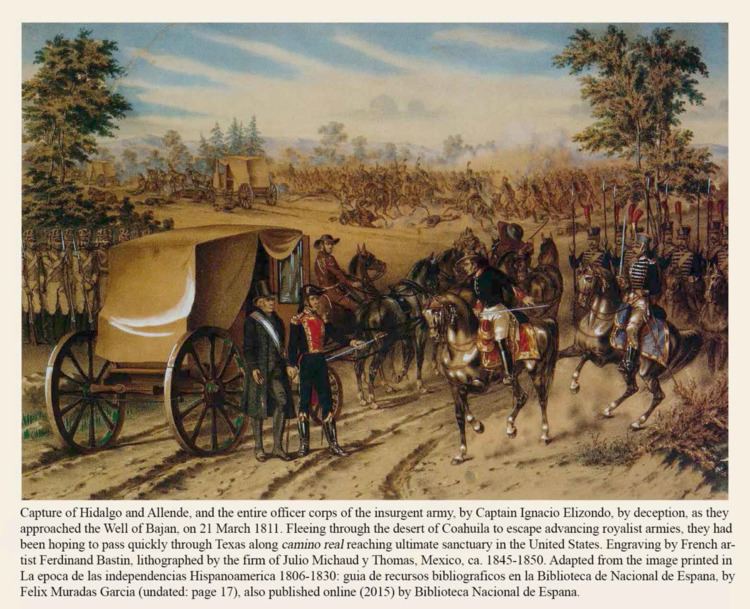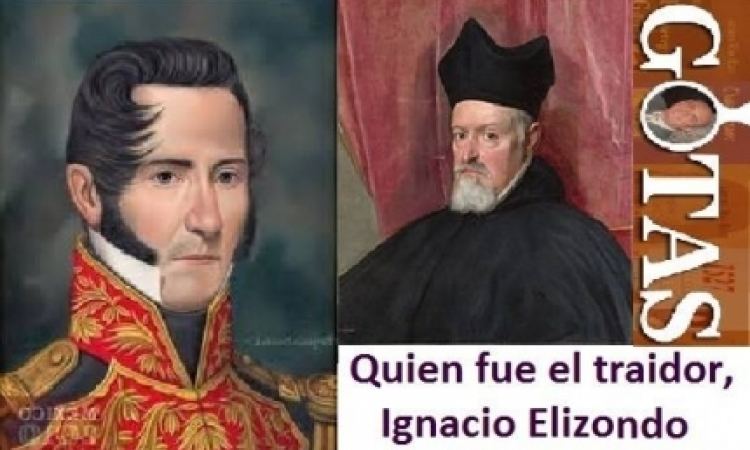Nationality Spanish Occupation Military | Name Ignacio Elizondo | |
 | ||
Full Name Francisco Ignacio Elizondo Villarreal Similar People Felix Maria Calleja del Rey - 1st, Jose Mariano Jimenez, Martin Javier Mina y Larrea, Francisco Javier Venegas, Miguel Hidalgo y Costilla | ||
Nos visit ignacio elizondo de due os del para so titulares y m s nbc deportes
Francisco Ignacio Elizondo Villarreal, (Salinas Valley, New Kingdom of León, New Spain, March 9, 1766 - San Marcos, Texas, New Spain, September 2, 1813), was a New Leonese royalist general, mostly known for his victorious plot to seek to capture important insurgency precursors of the Mexican War of Independence such as Miguel Hidalgo, Ignacio Allende, and Juan Aldama in Baján, Coahuila in 1811. Elizondo was born in the village of Salinas (now Salinas Victoria, Nuevo León). He was son of José Marcos de Elizondo and María Josefa de Villarreal. He was of Spanish and Basque ancestry.
Contents
- Nos visit ignacio elizondo de due os del para so titulares y m s nbc deportes
- GeneXus X Evolution 3 Features Overview Responsive Web Design Jos Ignacio Elizondo
- Personal life
- Counter insurrection movement
- Death
- References

GeneXus X Evolution 3 Features Overview: Responsive Web Design - José Ignacio Elizondo
Personal life

During his childhood, Elizondo lived in the village of Pesquería Grande (present-day Garcia, Nuevo León). His father owned many agricultural ranch stock properties then known as haciendas. In 1787, at the age of twenty-one he married María Gertrudis. She died on March 6, 1797, when she was giving birth his son, José Rafael Eusebio.
Ignacio Elizondo started his militar career in 1798, after being designated Lieutenant of Pesquería's provincial militia company. Two years later, he was honoured Captain of Punta de Lampazos provincial Dragons, one of the largest militar 'presidio' of the New Kingdom of León. However, one year later Elizondo occupied again his former position at the Pesquería's provincial militia. In 1806, governor Pedro de Herrera y Levya, commend him the control of the Eighth Dragon's company who would help Texas against the concurrent Apache attacks, already present in northern towns of the New Kingdom of León. Elizondo demanded viceroy through a letter to exempt himself from his position at the military command because this was making serious financial problems in some of his ranches and stock properties, among them some he previously bought to the church, in the same letter, he expressed the reprisals from governor Pedro de Herrera, that would cause the action of Elizondo's desertion. After, falling out with Herrera, indebted with the purchase of several haciendas from the church, he married María Romana Carrasco the same year, then he decided to change his residency to the Hacienda of San Juan de Canoas, in the province of Coahuila, where he also administrated the Hacienda of Alamo, jurisdiction of Monclova.
Counter-insurrection movement
Elizondo briefly left his military service prior to the Grito de Dolores and the outbreak of the Mexican War of Independence. In the Eastern Internal Provinces, the independence movement was not well received at first. Coahuila, Nuevo Santander, and Texas declared themselves for the royalists, but several towns eventually joined the cause. The governor of Nuevo León, Manuel de Santa María, eventually joined the rebels. Within Texas, Lt. José Menchaca and various filibuster expeditions acted to support the rebellion. Elizondo also joined the rebellion and commanded a small force in the Casas Revolt, in January 1811. However, Elizondo, vacillated in his support, marched through Nuevo León, Nuevo Santander, and Texas for the royalists, confronting the Gutiérrez–Magee Expedition in San Antonio, at the Battle of Alazan Creek, in 1813. Governor Santa María was removed from his post for the royalist Simón de Herrera. Some historians debate whether General Ramon Díaz de Bustamante or Bishop Primo Feliciano Marín de Porras finally won Elizondo over to the royalists, while others believe, he was converted by Manuel María de Salcedo of Texas and Simón de Herrera of Nuevo León, while the royalist governors were his prisoners, during his participation in the Casas Revolt. He was instrumental in the capture of Father Hidalgo, General Allende, and other rebel leaders at the Wells of Bajan (Norias de Bajan) in February 1811, which effectively ended the first phase of the rebellion. On August 18, 1813, at the Battle of Medina, leading a cavalry division of the Royal Spanish Army under command of Commandant-General of the Eastern Internal Provinces, Joaquin de Arredondo, he played a key role in defeating the Republican Army of the North and crushing the Gutiérrez–Magee Expedition, as well as the insurrection in Texas. Elizondo's last military service to his King was as the officer in command of a contingent of 500-cavalrymen dispatched by Arredondo from the capital at Bexar, to chase and mop-up the fleeing survivors of the insurgent army immediately after the Battle of Medina. His last reports (before the incident that led to his death on his return from this successful mission) detail his march along the Camino Real toward eastern Texas, where he captured and executed many of them at the Spanish villa of Trinidad de Salcedo (1807-1813) on Trinity River, which he depopulated and burned (see translation of Elizondo's final reports appended here).
..
Death
Elizondo's victory was praised by royalists, and even King Fernando VII, appointed him with a higher rank in the royalist army. However, his well-being didn't last too long, while trying to convert many towns in New Spain to royalism, (executing and imprisoning hundreds), he gained many enemies, hence hated by many insurgents, Ignacio Elizondo was critically wounded by Lieutenant Miguel Serrano, while sleeping on his encampment at the edge of the Brazos River and many historians aver he was buried a few days later on the bank of the San Marcos River, in Texas, New Spain, where he died as he was being carried back to the capital on a litter. However, if Col. Elizondo was, indeed, first interred on the banks of the San Marcos River, then his remains must have been exhumed later and re-buried in San Antonio, where on 9 October 1815, his burial was recorded in the campo santo record book at San Fernando cathedral as No. 715: "Ignacio Elizondo, Lt. Col. of the cavalry. Spanish, married to Romana Carrasco. He died of wounds received in a fist fight while he slept." It would be plausable that he be burried in San Antonio being that he administerd The Hacienda of Alamo which would have been The Alamo in San Antonio Texas.
